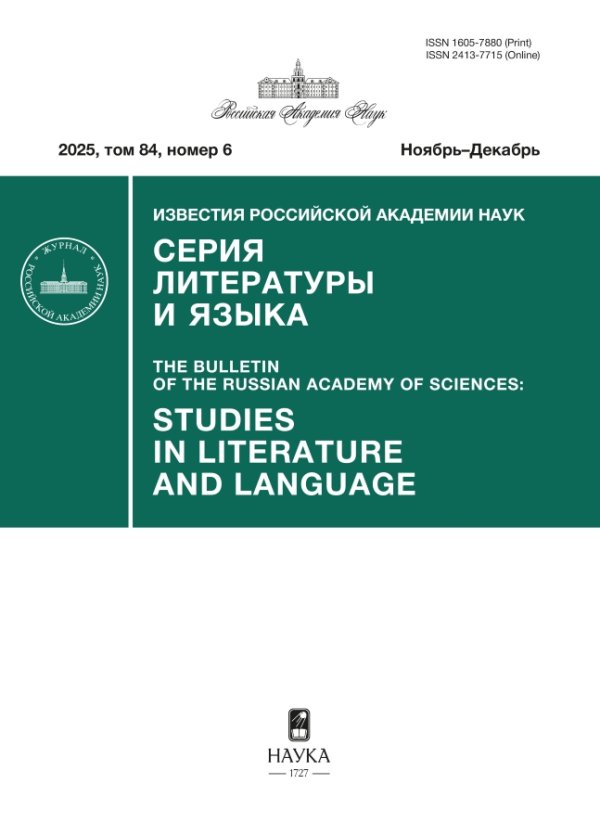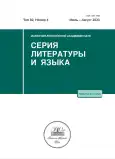Dynamics of Narrative Motives in Dostoevsky’s and Mamleev’s Novels
- Authors: Bogdanova O.A.1
-
Affiliations:
- A.M. Gorky Institute of World Literature of the Russian Academy of Sciences
- Issue: Vol 82, No 4 (2023)
- Pages: 25-34
- Section: Articles
- URL: https://journals.rcsi.science/1605-7880/article/view/140843
- DOI: https://doi.org/10.31857/S160578800027386-0
- ID: 140843
Full Text
Abstract
About the authors
Olga Alimovna Bogdanova
A.M. Gorky Institute of World Literature of the Russian Academy of SciencesRussian Federation, Moscow
References
- Силантьев И.В. Поэтика мотива. М.: Языки славянской культуры, 2004. 296 с.
- Ветловская В.Е. Анализ эпического произведения. Проблемы поэтики. СПб.: Наука, 2002. 211 с.
- Кибальник С.А. Проблемы интертекстуальной поэтики Достоевского. СПб.: ИД “Петрополисˮ, 2013. 432 с.
- Семыкина Р. О “соприкосновении мирам инымˮ: Ф.М. Достоевский и Ю.В. Мамлеев. Барнаул: БТПУ, 2007. 241 с.
- Мамлеев Ю.В. О Достоевском // Мамлеев Ю.В. Бывает… М.: Эннеагон, 2008. С. 13–14.
- Мамлеев Ю.В. Россия вечная. М.: Традиция, 2020. 232 с.
- Сараскина Л.И. Человеческое и… иное измерение. Два диалога с писателем Юрием Мамлеевым // Сараскина Л.И. Непреодоленное: Диалоги двух десятилетий. Тула: Ясная поляна, 2009. С. 57–68.
- Нефагина Г.Л. Русская проза конца XX в.: Учебное пособие. М.: Флинта: Наука, 2003. 320 с. (О Мамлееве. С. 217–221).
- Григорян А. Дойти до дна ада: Достоевский, Сологуб, Мамлеев // Вопросы литературы. 2016. Сентябрь–октябрь. С. 81–101.
- Трунин С.Е. Рецепция Достоевского в русской прозе конца XX – начала XXI в. Минск: Логвинов, 2006. 156 с.
- Бойко М. Метакритика метареализма. М.: Литературные известия, 2010. 92 с.
- Хайдеггер М. Что такое метафизика? / пер. с нем. В.В. Бибихина. 2-е изд. М.: Академический Проект, 2013. 288 с.
- Черняк М.А. Актуальная словесность XXI века. Приглашение к диалогу: Учебное пособие. 2-е изд. М.: Флинта, 2015. 233 с.
- Долинин А.С. Блуждающие образы (О художественной манере Достоевского) // Вестник литературы. 1921. № 2. С. 1–3.
- Достоевский Ф.М. Полн. собр. соч.: в 30 т. Т. 1–30. Л.: Наука, 1972–1990.
- Иоанн Лествичник, преп. Лествица. Слово 15. О нетленной чистоте и целомудрии, которое тленные приобретают трудами и потами. [Электронный ресурс] https://azbyka.ru/otechnik/Ioann_Lestvichnik/lestvitsa-ili-skrizhali-dukhovnye/20
- Добротолюбие: в 5 т. М.: Сибирская Благозвонница, 2010. Т. 1. 554 с.
- Иоанн Златоуст, свт. Избранные творения: в 2 т. М.: Изд-во Сретенского монастыря, 2006. Т. 2. 429 с.
- Бердяев Н.А. Миросозерцание Достоевского // Бердяев Н.А. Русская идея. Миросозерцание Достоевского. М.: Изд-во “Эˮ, 2016. С. 311–510.
- Касаткина Т.А. Святая Лизавета // Касаткина Т.А. Характерология Достоевского. Типология эмоционально-ценностных ориентаций. М.: Наследие, 1996. С. 186–189.
- Тихомиров Б.Н. “Лазарь! Гряди вон!ˮ Роман Ф.М. Достоевского “Преступление и наказаниеˮ в современном прочтении: Книга-комментарий. СПб.: Серебряный век, 2005. 472 с.
- Мамлеев Ю.В. Крылья ужаса: Роман // Мамлеев Ю.В. Собр. соч. Т. 3. М.: Эксмо, 2018. С. 7–54.
- Мамлеев Ю.В. Блуждающее время: Роман // Мамлеев Ю.В. Собр. соч. Т. 2. М.: Эксмо, 2017. С. 65–199.










